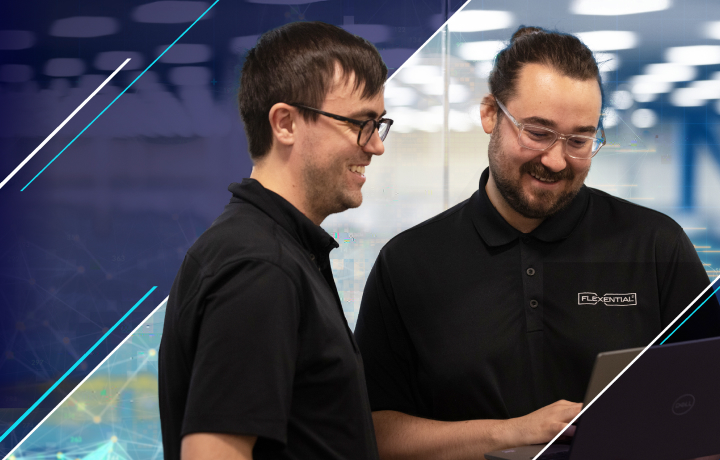Essentials for VMware Virtual Desktop Infrastructure (VDI)
Set your remote teams up for success by implementing VDI essentials that provide secure, high-performing virtualized desktops.

Virtual desktop infrastructure (VDI) refers to the use of virtual machines to provide and manage virtual desktops. It hosts desktop environments on a centralized server and deploys them to end-users on request. A hypervisor—or a virtual machine monitor—segments servers into guest virtual machines, or VMs. These VMs host virtual desktops where users can access the corporate LAN and associated resources and applications remotely from any device and any location.
As COVID-19 drove the workforce from the corporate office to the home office, the ability to work remotely without compromising business continuity became more valuable than ever before. VDI offers multiple advantages for business continuity, such as user mobility, ease of access, flexibility, ease of updates, configurations and patching, and greater security.
Previously, VDI’s high-performance requirements made it challenging to deploy on legacy systems. But with the rise in enterprise adoption of hyper converged infrastructure (HCI)—a software-defined, unified system that combines all the elements of a traditional data center (storage, network, server, and hypervisor in a single consolidated purpose-built system)—businesses can now enjoy scalability, high availability, and high performance at a lower cost.
A VDI solution can help an organization achieve a multitude of benefits. This solution provides a modern platform for the secure delivery of virtual desktops and apps across the hybrid cloud. VDI broker choices like Horizon or Citrix can be enabled in DaaS solutions. This is a viable option if your organization is looking to try the features of VDI out for a certain period, since Desktop-as-a-Service (DaaS) is basically VDI outsourced by a third-party provider.
But what do businesses need in order toto guarantee that their VDI implementation goes off without a hitch? Consider the following benefits and essentials for VMware VDI deployment.
Benefits of VDI
At the onset of the pandemic, a high volume of users required remote access to carry out their jobs while working from home. On the other hand, organizations needed to ensure that enterprise IT security would not be jeopardized as employees took corporate devices and connected them to their home networks.
Organizations with a VDI solution in place instantly witnessed the value of two key benefits of VDI: remote access and security. VDI users can connect to their virtual desktop environment from any location or device, making it easy for employees to access all of their files and applications and work remotely from anywhere in the world. Additionally, data lives on the server rather than the end client device in a VDI environment, which protects corporate data if an endpoint device is ever stolen or compromised.
VDI also increases cost savings for businesses. Because the server executes the processing, the hardware requirements for end-user devices are much lower. Users can access their virtual desktops from older devices, thin clients, or even tablets, reducing the need for IT to purchase new and expensive hardware. Furthermore, VDI’s centralized server format allows IT to easily patch, update, or configure all virtual desktop infrastructure in a system, making for greater centralized management.
Steps to VMware VDI implementation
With organizations adapting to long-term remote work policies, VDI has proven itself to be a key component in business success. But what does a business need to do to ensure that its VDI deployment goes as smoothly as possible? Consider the following best practices to help successfully implement your VMware VDI solution.
Make note of your current infrastructure:
When planning for VDI deployment, larger enterprises should consider implementing it in an HCI environment, as HCI’s scalability and high performance are a natural fit for VDI’s resource needs. HCI is more responsive to rapidly changing business needs. In fact, organizations can set up hardware in just a few hours and spin up workloads in minutes. What’s more, HCI solutions come pre-tested and pre-certified with published best practices deployment metrics on things like scalability and performance so enterprises can be confident in how many users the system can reliably support without usability degradation. On the other hand, implementing HCI for VDI is probably not necessary (and would be overly expensive) for organizations that require less than 100 virtual desktops. Taking inventory of your current infrastructure will allow you to determine whether extra preparation is required for VDI implementation.
Prepare your network:
Since VDI performance is so closely linked to network performance, it’s important to know peak usage times and anticipate demand spikes to ensure sufficient network capacity. For example, if you have teams spread out across the globe, their network demands likely fluctuate. It’s likely that their network demands fluctuate with their time zones. Taking this into consideration when it comes time to deploy virtualization technology will allow you to determine the proper network performance required of certain teams at specific times.
Use Desktop-as-a-Service (DaaS) to power your remote workforce:
Desktop-as-a-Service, or a DaaS solution, is a cloud-based desktop virtualization service hosted by a third-party cloud provider that manages all back-end resources such as desktop storage, compute, and networking. Meanwhile, the DaaS provider streams the virtual desktops to endpoint devices, allowing any time, anywhere access to desktops and applications.
DaaS benefits that help power remote work include centralized management, and security, and compliance. Centralized management makes it easy to provision new virtual desktops, add a new application, and perform upgrades and patching which scales to thousands of virtual desktops. DaaS also provides secure access to company data without storing anything on local devices and access control using authentication.
By providing instant access to a virtualized desktop that offers enterprise-class connectivity, security, and performance, businesses can better navigate the remote work landscape and set their workforce up for success. Find out what VDI essentials are necessary for your remote workforce.







